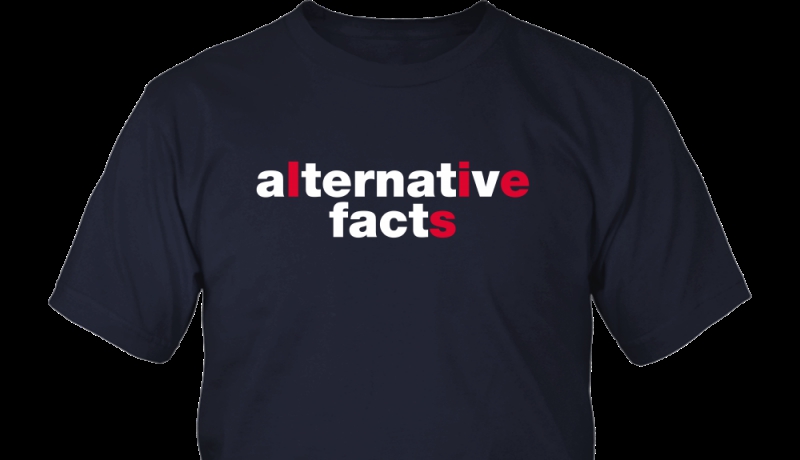When we try to deny the undesirable fact, we choose from following three options.
- We search for counter-arguments, trying to fit the fact in a larger context and find a positive trend (for example, black is bad, but all in all black has a slightly gray tint, which is already good).
- We blur facts by either moving them to the domain of folklore or by showing that it all depends on the perspective (for example, black is not black, when the viewer is black).
- We attack people accusing them of bias (for example, change the color yourself, before criticizing it).
In any case, denying facts requires certain manipulative abilities. The denier has to convince people that it isn’t the fact that matters but the hidden emotions behind it. As you perceive things that is how they will be. And if you recognize a bad fact, then you want to see the bad.
Anyone who comes to power wants facts to speak in their favor (things were bad, now that I am here they’re better). And since they cannot change facts, the objective reality, they begin to alter their perception of facts. The result can be very interesting.
Thanks to US President, the expression “alternative facts” began to be widely used. It addresses journalists and is accepted by journalists as a joyful and a dangerous way to distort reality.
It all began after Donald Trump’s inauguration as President of the United States when in his first appearance in the White House briefing room Press Secretary Sean Spicer told journalists that they did not present facts accurately as they made the crowd at President Trump’s inauguration look smaller.
Media named Spicer’s words falsehood. US Counselor to Donald Trump Kellyanne Conway explained that Spicer didn’t utter a falsehood, he gave “alternative facts.” Media responded with: “Look, alternative facts are not facts. They’re falsehoods.”
Trump’s administration invented and widely used the phrase “alternative facts” trying to prove that there is no difference between the truth and a lie. And if that’s the case, then we can easily call any fact fake (which US President happily does on his Twitter page).
Generally, Trump’s relationship with media is quite tense and passionate. Perhaps, the American media is not used to such unambiguous and dubious attacks. And it chooses to use mockery and humor as a coping mechanism ( the hashtag “alternative facts” is trending on social media).
We, unlike Americans, are used to the alternative life.
The Soviet years taught us how to live not only in the alternative but also in the ambiguous situations.We all knew what the reality was but we were expecting a completely different picture from the media. The media had nothing to do with life, and that was perceived as the norm.
That’s how we live these days, when we hear and read calls, admonitions, and commands to believe the alternative. Remember the Armenian President’s speech on “lukewarm atmosphere”. The term “lukewarm atmosphere” acquired a negative meaning and was suggested as an alternative reality. According to the President, the reality is better and brighter but some people, especially journalists, blacken it and make it lukewarm.
“The core reason for emigration is this lukewarm atmosphere, people don’t see a light in the end of the tunnel, they have no hopes. Why, because for many years at least two TV channels, dozens of printed and electronic media have been talking about the very worst, have been only blackening the picture,” said the President.
Recently, in Gyumri, the Prime Minister advised journalists, who were asking him questions: “You cannot change the country with such mood … Change your mood a little, smile a little, you all look so angry…”
When journalists replied that it was impossible to be optimistic in Gyumri, a city burdened with social issues, the Prime Minister responded in a folklore style: “Well then be constantly sad.”
It turns out that if you can not influence the fact, or even mention it, then you need to change the perspective. Black is not black, it is black in the eyes of the viewer. And for it not to be black, you need to change your way of seeing it (“sad”, “lukewarm”) and smile.
It’s certainly a good meditation practice, but media representatives do not meditate, they summarize signs of life.
Today these signs are perceived as a paradox. And paradoxical ambiguous summaries are the most needed. It is not a surprise that George Orwell’s “1984” rose to the top of the Amazon best-seller list. Decades ago the British writer said that; “War is peace. Freedom is slavery. Ignorance is strength.”
It’s hard to live a long life with alternative facts and in a joyful mood (not “bitter”); your health is endangered.
This coexistence of parallel realities endangers a person’s mental stability and forces them into cognitive dissonance. And if you don’t want to go mad, you need to choose one of the following perceptions about life: the real or the alternative.
In this paradoxical situation, the media has only one solution: resistance. It needs to distinguish facts from alternatives with patience and persistence, and consider each fact from ground zero instead of a level that was subjected to manipulation.
The fact is primary, the attitude is secondary.
Nune Hakhverdyan







